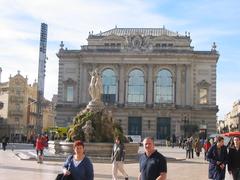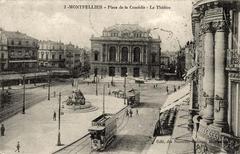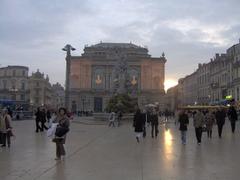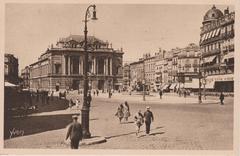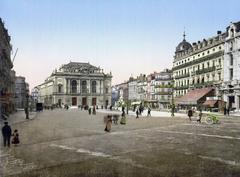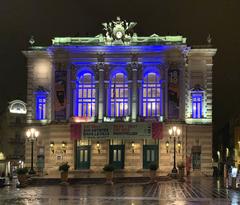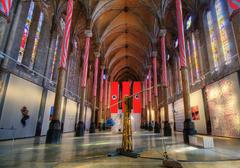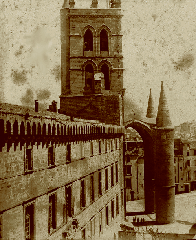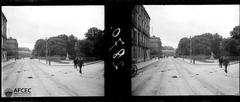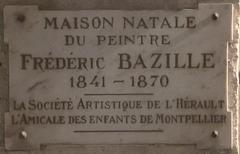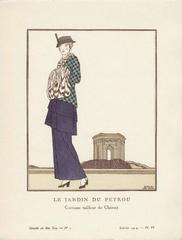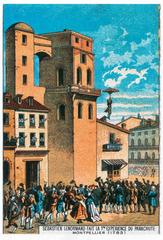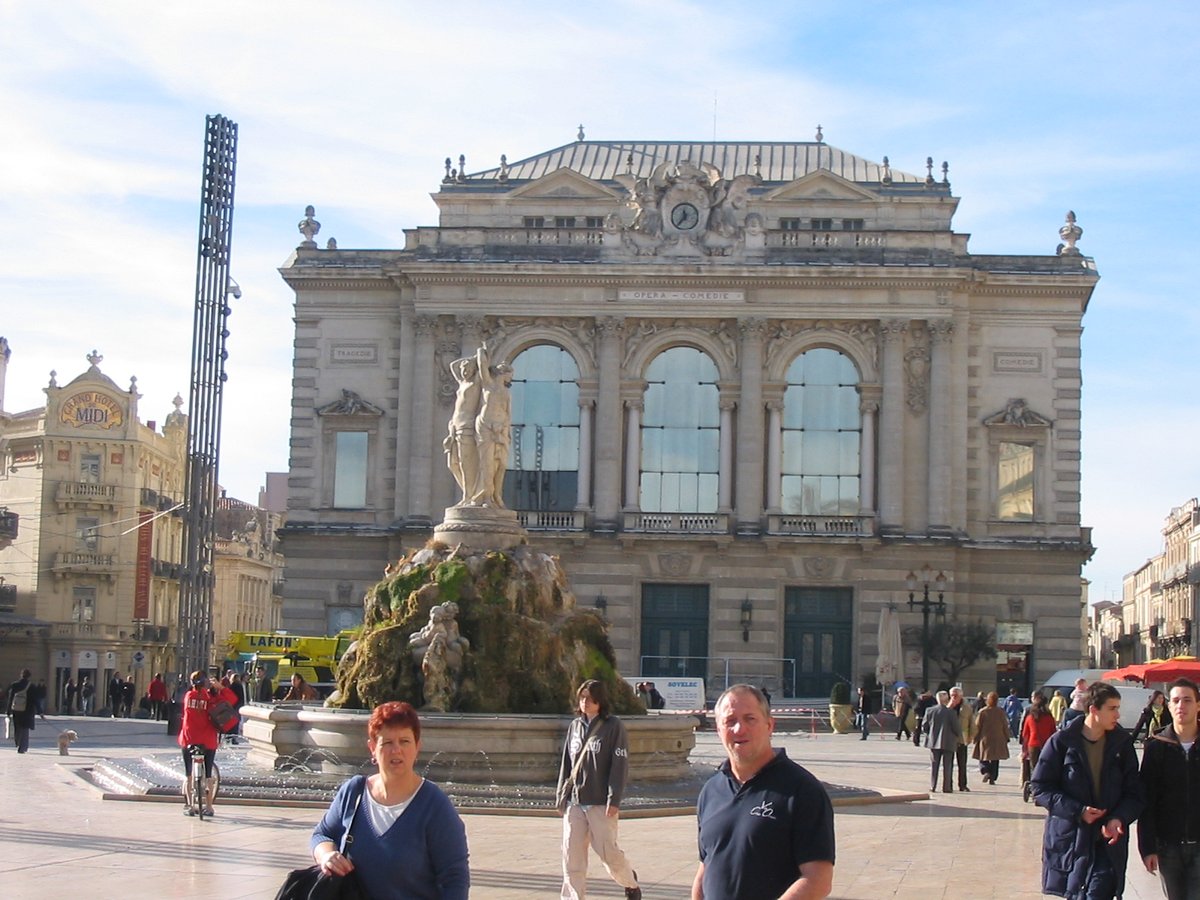
Opéra National de Montpellier: Visiting Hours, Tickets, and Guide to Montpellier Historical Sites
Date: 14/06/2025
Introduction: History and Cultural Significance
Situated in the bustling heart of Montpellier, France, the Opéra National de Montpellier stands as a testament to the city’s enduring commitment to the performing arts, architectural splendor, and civic pride. Established in 1755, this distinguished institution has been at the forefront of French cultural life for centuries, evolving from its Enlightenment-era origins into a modern hub for opera, symphonic music, and innovative performances. Its two principal venues—the ornate, 19th-century Opéra Comédie and the contemporary Opéra Berlioz at Le Corum—reflect both the city’s rich historical legacy and its vibrant present (Wikipedia; Google Arts & Culture; Montpellier Tourism).
Whether you are an opera lover, architecture enthusiast, or a cultural traveler, this comprehensive guide provides everything you need to know: visiting hours, ticketing, accessibility, travel tips, and nearby attractions. You’ll also discover the opera’s unique place in Montpellier’s social and cultural fabric, and how to plan a memorable visit to the city’s historic sites (official website; Royal Hotel Montpellier).
Table of Contents
- Introduction
- Historical Development
- Architectural Highlights
- Practical Visitor Information
- Performance Schedules & Highlights 2024–2025
- Cultural Significance
- Accessibility & Community Engagement
- Nearby Attractions & Travel Tips
- Frequently Asked Questions (FAQ)
- Notable Features & Anecdotes
- Planning Your Visit
- Summary & Key Recommendations
- References
Historical Development of the Opéra National de Montpellier
Origins and Early Years
The origins of the opera in Montpellier trace back to 1755 with the establishment of the city’s first opera company, a reflection of the Enlightenment-era surge in cultural investment across France (Wikipedia). Early productions were staged in various locations, but the city’s growing reputation soon demanded a permanent, grand venue.
Opéra Comédie: Construction and Architectural Heritage
After several devastating fires, a design competition in the late 1800s led to the construction of the current Opéra Comédie, completed in 1888 by Joseph Marie Cassien-Bernard, a student of Charles Garnier. The Italian-style theater features a horseshoe-shaped auditorium with five tiers and seats for 1,200, and is renowned for its gilded interiors, velvet draperies, intricate sculptures, and the intimate Salle Molière concert hall (Google Arts & Culture; Montpellier Tourism).
A unique tradition is the hand-wound monumental clock on the façade, maintained weekly, linking the present to the opera’s storied past.
Restoration and Expansion
Over its lifetime, the Opéra Comédie has survived three major fires and undergone meticulous restoration, enhancing both its acoustics and architectural integrity. In 1990, the opening of the modern Opéra Berlioz in the Corum conference center expanded the institution’s capabilities with a 2,000-seat, state-of-the-art auditorium (Royal Hotel Montpellier).
Orchestre National Montpellier Occitanie
Founded in 1989, the resident orchestra features up to 93 musicians and a 31-artist choir, performing a wide repertoire from Baroque to contemporary works and actively participating in community outreach (Google Arts & Culture).
National Recognition
Elevated to “Opéra National” status by the French Ministry of Culture in 2002, the institution continues to thrive under the artistic direction of leading conductors, including Roderick Cox as of 2024 (Première Loge).
Architectural Highlights
Opéra Comédie
Standing on the Place de la Comédie, the Opéra Comédie is an exemplar of 19th-century Italianate theater, with a façade adorned with classical columns and sculptures. Inside, its horseshoe-shaped auditorium, gilded balconies, and Belle Époque decor create an opulent setting for the arts (official website). The Salle Molière, a secondary hall, is ideal for chamber concerts and recitals.
Modern renovations have equipped the venue with advanced rigging, lighting, and improved accessibility while preserving its historic character.
Opéra Berlioz at Le Corum
Located at the Esplanade Charles de Gaulle, Le Corum is a contemporary complex designed by Claude Vasconi, opened in 1990. The Opéra Berlioz boasts 2,000 seats, cutting-edge acoustics, and flexible staging, making it ideal for large-scale operas, symphonic concerts, and international conferences.
Practical Visitor Information
Visiting Hours
- Opéra Comédie: Tuesday–Saturday, 10:00 AM–6:00 PM (hours may vary on performance days or during special events).
- Opéra Berlioz: Open during scheduled performances and events.
Check the official website for the latest updates.
Tickets and Booking
Tickets can be purchased online, at the box office, or through authorized vendors. Prices typically range from €10–€80, depending on the production and seating. Discounts are available for students, youth, seniors, and visitors with disabilities. Early booking is advised, especially for popular events.
Accessibility
Both venues offer step-free access, elevators, ramps, and designated wheelchair seating. Assistance services and adapted performances (including sign language, audiodescription, and tactile tours) are available. Contact the box office in advance to arrange specific accommodations.
- Assistance for hearing and visual impairments is available for select performances.
- Guide dogs are welcome with prior notification.
Getting There
- Opéra Comédie: Located at Place de la Comédie, close to Montpellier’s main train station and accessible via tram lines 1 and 2.
- Le Corum: Esplanade Charles de Gaulle, served by tram lines 1 and 4.
- Parking: Underground garages (Comédie, Polygone, Corum) are available, though public transport is recommended (Montpellier public transport).
Guided Tours & Special Events
Occasional guided tours reveal the opera’s backstage and architectural secrets. Special events include family workshops, open rehearsals, and festivals such as the Festival Radio France Occitanie Montpellier and Arabesques (Montpellier Tourism).
Dress Code and Etiquette
Smart casual attire is recommended, with elegant wear for galas or premieres. Arrive at least 30 minutes before the performance; latecomers may need to wait until an intermission to be seated.
Photography
Photography is permitted in public areas and foyers, but strictly prohibited during performances.
Performance Schedules & Highlights 2024–2025
With over 300 annual performances, the Opéra’s 2024–2025 season includes grand operas, symphonic concerts, chamber music, and innovative formats.
Key Performances
- La forza del destino (Verdi): September 22, 24, 27, 2024
- Le Voyage dans la lune (Offenbach): December 15, 17, 20, 22, 2024
- Médée (Cherubini): March 8, 11, 13, 2025
- Mitridate, re di Ponto (Mozart): April 8, 10, 12, 2025
- Bluebeard (Offenbach): April 29, 30, 2025
Programming
- Diverse repertoire: classical, baroque, contemporary, world music.
- Educational programs: Opéra Junior for ages 4–29, workshops, and family events.
- Special formats: ciné-concerts, immersive experiences, escape games.
See the official schedule for full details.
Cultural Significance
Civic Identity
The Opéra is a symbol of Montpellier’s urban identity, with its prominent location and stewardship of local icons like the original marble Three Graces statue inside the Opéra Comédie (Montpellier Tourism).
Artistic Innovation
With over 200 performances per year, the institution embraces both tradition and innovation, supporting new works, multidisciplinary collaborations, and emerging talent (Google Arts & Culture).
Community Engagement
The Opéra National de Montpellier is committed to inclusion, offering performances in schools, prisons, and community centers, as well as accessible and family-friendly programming (Royal Hotel Montpellier).
Accessibility & Community Engagement
- Physical access: Step-free, elevators, and adapted seating.
- Sensory access: Performances with audiodescription, sign language, and tactile tours.
- Discounted tickets: For visitors with disabilities and their companions.
- Community outreach: Educational concerts, open rehearsals, and cultural festivals.
Nearby Attractions & Travel Tips
- Place de la Comédie: The city’s central square, home to cafés and the Fountain of the Three Graces.
- L’Écusson (Old Montpellier): Medieval quarter with cobblestone streets and artisan shops.
- Musée Fabre: Renowned art museum just a short walk from the opera.
- Esplanade Charles de Gaulle: Green promenade beside Le Corum.
- Cathédrale Saint-Pierre: Gothic cathedral within walking distance.
Dining: The surrounding area offers a range of restaurants and cafés for pre- or post-performance dining.
Day Trips: Consider excursions to Plage de l’Espiguette, Nîmes, or Carcassonne for extended cultural exploration.
Safety: Montpellier is generally safe, but standard precautions are advised.
Frequently Asked Questions (FAQ)
Q: What are the opera’s visiting hours?
A: Opéra Comédie is open Tuesday to Saturday, 10:00 AM–6:00 PM. Opéra Berlioz is open during scheduled performances.
Q: How do I buy tickets?
A: Via the official website, box office, or authorized agents. Early booking is recommended.
Q: Are there discounts for students or visitors with disabilities?
A: Yes, discounted rates are available for students, youth, seniors, and visitors with reduced mobility.
Q: Is the venue accessible?
A: Both venues are wheelchair accessible and offer adapted services.
Q: Can I take photographs?
A: Only in public areas, not during performances.
Q: What are nearby attractions?
A: Place de la Comédie, L’Écusson, Musée Fabre, Esplanade Charles de Gaulle, and Cathédrale Saint-Pierre.
Notable Features & Anecdotes
- Three Graces Statue: The original marble statue is housed inside Opéra Comédie; a replica stands outside (Montpellier Tourism).
- Hand-Wound Clock: The monumental clock is still wound by hand each week (Google Arts & Culture).
- Architectural Lineage: The theater’s design connects Montpellier to the legacy of Paris’s Palais Garnier (Google Arts & Culture).
Plan Your Visit
For up-to-date information, event schedules, and ticketing, visit the official Opéra Orchestre National Montpellier website. Download the Audiala app for audio guides, digital ticketing, and exclusive content. Follow the opera on social media for the latest news, and explore related articles for more on Montpellier’s history and attractions.
We look forward to welcoming you to the Opéra National de Montpellier—where history, music, and architecture converge for an unforgettable experience!
Summary & Key Recommendations
- The Opéra National de Montpellier is a must-see for culture lovers, offering a rich blend of historic elegance, world-class performances, and community engagement (Google Arts & Culture; Montpellier Tourism).
- Plan your visit by checking schedules, booking tickets in advance, and exploring nearby historical sites.
- Leverage accessibility services and guided tours for a deeper experience.
- Use the official website, Audiala app, and local tourism resources for real-time updates and recommendations (Première Loge).
References
- Wikipedia: Opéra National de Montpellier
- Google Arts & Culture: Opéra Comédie Opera Orchestre Montpellier
- Montpellier Tourism: Opéra Comédie and Le Corum
- Opéra National de Montpellier Official Website
- Royal Hotel Montpellier: Opéra National de Montpellier
- Première Loge: Saison 24-25 de l’Opéra Orchestre National de Montpellier
